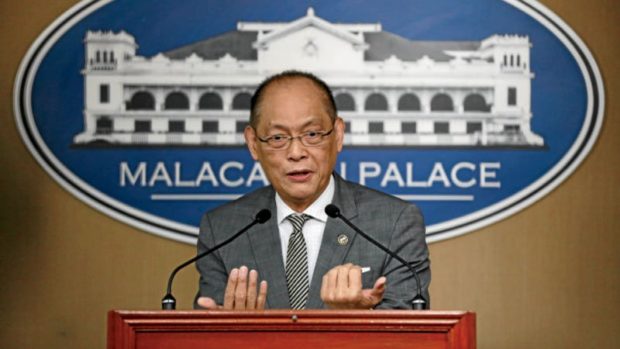A day after changing hats, new BSP chief softens stance on monetary easing

Former Budget Secretary now BSP Governor Benjamin E. Diokno. (File photo from the Philippine Daily Inquirer)
MANILA, Philippines–The Philippines’ new central bank chief — on his second day on the job, Friday — said he prefers to wait for fresh data to confirm that the inflation rate is indeed on a downtrend before pushing for a reduction in interest rates or bank reserve requirements.
In his first press briefing as the country’s top financial regulator, Bangko Sentral ng Pilipinas Gov. Benjamin Diokno softened his aggressive pro-monetary easing rhetoric aired earlier in the week immediately following Malacañang’s announcement of his appointment.
“I did not make those statements right here, right? I made those statements in my other capacity [as the former Budget Secretary], remember that?” he said when asked about his comments last Tuesday saying that “BSP’s role is to ensure steady, strong growth” in addition to its traditional task of fighting inflation and, to achieve this, “monetary policy has to be in sync with fiscal policy.”
Diokno stressed that, while he still believes that Philippine banks’ reserve requirements — currently at 18 percent of their total deposits, the highest in the region — should be reduced sharply, the timing of any such moves would be determined together with the six other members of the BSP’s Monetary Board.
“Our policy will be determined by a clear analysis that will be data driven and evidence based, and it will be decided on by the board,” he said. “I cannot, on my own, decide on the cut of the reserve requirement. But that will be taken up by the board as a collegial body.”
Last year, the central bank reduced banks’ reserve requirement ratio by 200 basis points, freeing up almost P200 billion in cash that could be used more productively as loans by financial institutions.
The late Gov. Nestor Espenilla Jr. said the ideal reserve level for banks was in the single-digit level as the funds could be better employed to feed the growing Philippine economy. But his drive to cut bank reserves was derailed by a sudden spike in the inflation rate last year, which required the central bank to hike interest rates by a total of 175 basis points.
Diokno — who had earlier excited financial markets with the prospect of cheaper funds that buoyed the local stock market and put pressure on the peso — toned down his enthusiasm for immediate aggressive action, saying the “well represented, very wise and old” Monetary Board will decide together on policy “based on data, evidence and the situation at that time.”
“In my other capacity [as Budget Secretary], I said our reserve requirement was still too high,” he said. “We will probably move somewhere, but the timing is important. We know that inflation has been on a downward spiral, but personally I would like to see a few more data points rather than making a decision at this time.”
During the press briefing, Diokno was flanked by Deputy Governor Diwa Guinigundo who had consistently expressed in recent weeks the need for further evidence of easing inflation before easing monetary policy. In contrast, banks have been clamoring for the central bank to either cut interest rates or reduce bank reserves to address what they said is an increasingly tight liquidity liquidity situation in local financial markets.
Last Tuesday, the Philippine Statistics Authority announced the inflation in February fell to 3.8 percent, lower than the 4.4 percent in January — and the third consecutive month of decline — boosting sentiment for monetary easing under the new governor.
The Monetary Board will convene on Mar. 21 to decide on the direction of interest rates or reserve requirements.
“I’m an action person,” Diokno said. “If there’s a decision [to be made], I want it done as soon as possible. There’s no point in postponing. I’m known for that.” /jpv